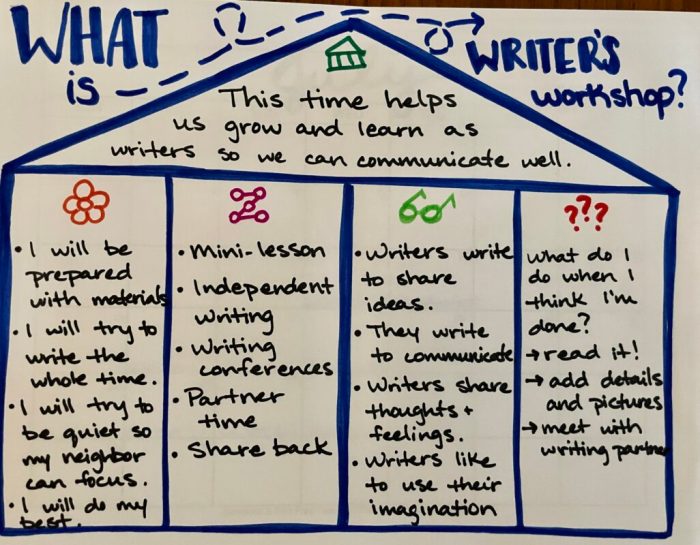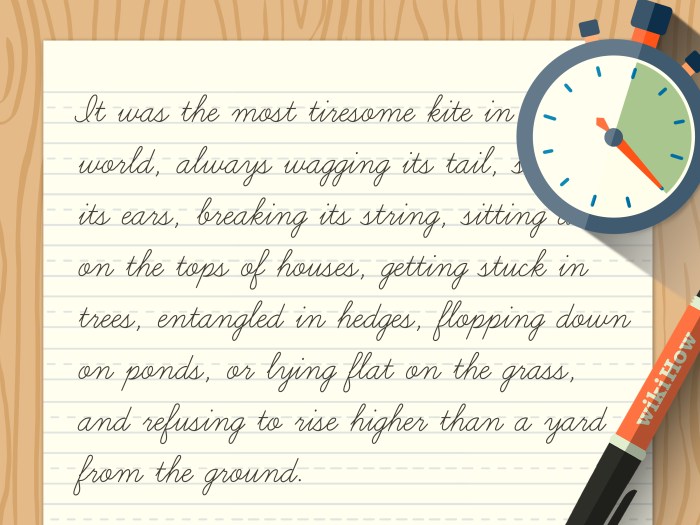Writing Tutorials and Guides sets the stage for this enthralling narrative, offering readers a glimpse into a story that is rich in detail with an American high school hip style and brimming with originality from the outset.
Get ready to dive into the world of writing tutorials and guides, where creativity meets instruction in a seamless blend of knowledge and flair.
Introduction to Writing Tutorials and Guides

Writing tutorials and guides serve the purpose of providing step-by-step instructions and valuable information on a particular topic to help readers understand and learn a new skill or concept. These resources are essential for breaking down complex information into manageable chunks and guiding individuals through the learning process.
Importance of Clear and Concise Steps
Clear and concise steps are crucial in writing tutorials and guides to ensure that readers can easily follow along and implement the instructions effectively. By presenting information in a straightforward manner, writers can help readers grasp the content quickly and avoid confusion or misinterpretation.
- Clear steps eliminate ambiguity and make it easier for readers to understand the process.
- Concise instructions save time and prevent readers from feeling overwhelmed by unnecessary details.
- Well-structured tutorials and guides enhance the overall learning experience and increase the likelihood of successful outcomes.
Examples of Popular Tutorials and Guides
Some popular examples of tutorials and guides include:
- How to Create a WordPress Website: A comprehensive guide for beginners to set up a website using WordPress.
- Photography Editing Tutorial: Step-by-step instructions on editing photos using Adobe Photoshop.
- Coding Basics Guide: An introduction to coding languages and programming concepts for beginners.
Target Audience for Writing Tutorials and Guides
The target audience for writing tutorials and guides can vary depending on the topic and complexity of the content. However, these resources are generally aimed at:
- Beginners looking to learn a new skill or concept from scratch.
- Intermediate learners seeking to enhance their knowledge and improve their skills.
- Advanced users interested in mastering specific techniques or advanced topics within a field.
Structure and Organization
When it comes to creating tutorials and guides, having a clear and effective structure is key. This not only helps the reader understand the information better but also keeps them engaged throughout the content.
Typical Structure of a Tutorial or Guide
To organize your content effectively, it’s important to start with a strong introduction that Artikels what the tutorial or guide will cover. Then, break down the information into sections or steps, making sure to use headings and subheadings to clearly indicate each part. Finally, wrap up with a conclusion that summarizes the key points and provides any additional resources or next steps for the reader.
Tips for Organizing Content Effectively
– Use bullet points or numbered lists to break down complex information into easy-to-digest chunks.
– Group related topics together to maintain a logical flow throughout the tutorial or guide.
– Include visuals like diagrams or screenshots to enhance understanding and engagement.
– Make use of tables to present data or comparisons in a clear and organized manner.
Importance of Logical Flow in Tutorials and Guides
A logical flow is crucial in tutorials and guides as it helps the reader follow the information easily from start to finish. Without a clear structure, the content can feel disjointed and confusing, leading to a loss of interest from the reader.
Best Practices for Creating an Artikel Before Writing
Before you start writing your tutorial or guide, it’s essential to create an Artikel that Artikels the main topics to be covered and the order in which they will be presented. This will help you stay focused and ensure that your content flows smoothly from one point to the next.
Writing Style and Tone: Writing Tutorials And Guides

When it comes to writing tutorials and guides, the style and tone you use can greatly impact how effective your content is in reaching and engaging your audience. Let’s dive into some key points to consider when it comes to writing style and tone.
Formal vs. Informal Tones
In tutorials, a formal tone is often used when presenting complex or technical information. This tone is characterized by professional language, proper grammar, and a serious demeanor. On the other hand, an informal tone is more conversational, relaxed, and often includes humor or personal anecdotes to connect with the reader on a more casual level.
Importance of Plain Language
Using plain language is crucial for ensuring that your audience can easily understand the content you are presenting. Avoiding jargon, complex terminology, and convoluted sentences will help make your tutorials more accessible and user-friendly for a wider range of readers.
Consistent Tone Tips
To maintain a consistent tone throughout your tutorial or guide, it’s important to establish the tone you want to use from the beginning and stick to it. Consider the audience you are writing for and tailor your tone to match their expectations and preferences. Whether it’s formal, informal, friendly, or authoritative, consistency in tone will help create a cohesive and engaging reading experience for your readers.
Visual Aids and Examples
Visual aids play a crucial role in tutorials and guides by enhancing the understanding of complex concepts through the use of images, diagrams, and videos. Incorporating visual elements can make the content more engaging and help readers grasp the information more effectively.
Incorporating Images, Diagrams, and Videos
Using images, diagrams, and videos in your writing can significantly enhance the learning experience for readers. Here are some tips for incorporating visual aids:
- Choose high-quality images that are relevant to the content and support the key points you are trying to convey.
- Create clear and informative diagrams that illustrate processes, relationships, or concepts that may be difficult to explain in words alone.
- Include videos that demonstrate practical applications, step-by-step tutorials, or real-life examples to provide a comprehensive understanding of the topic.
Examples for Enhanced Understanding
Examples are powerful tools that can help readers connect theoretical concepts to real-world scenarios. Here are some best practices for choosing and creating examples:
- Use relatable and diverse examples that appeal to a wide range of readers and demonstrate the practical application of the concepts being discussed.
- Provide step-by-step explanations alongside examples to guide readers through the thought process and decision-making involved.
- Ensure that examples are accurate, relevant, and up-to-date to maintain the credibility of the content and avoid confusion or misinterpretation.
Interactive Elements
Interactive elements play a crucial role in enhancing the learning experience for users engaging with tutorials and guides. By incorporating quizzes, interactive diagrams, and exercises, these elements not only make the content more engaging but also help reinforce the concepts being taught.
Quizzes
Quizzes are a great way to test the audience’s understanding of the material. They provide immediate feedback, allowing users to assess their knowledge and identify areas that may require further review. Including quizzes at the end of each section or tutorial can help solidify the key takeaways and ensure retention of information.
- Quizzes can be in the form of multiple-choice, true/false, or fill-in-the-blank questions.
- Interactive quizzes can be used to track progress and provide customized feedback based on the user’s responses.
- Integrating quizzes throughout the tutorial keeps users actively involved and motivated to continue learning.
Interactive Diagrams
Interactive diagrams allow users to explore complex concepts visually. By interacting with different elements of the diagram, users can gain a deeper understanding of how components are connected and how they function together. These diagrams are especially helpful for subjects that involve processes or systems.
- Users can zoom in/out, click on specific parts for more information, or manipulate variables to see the effects in real-time.
- Interactive diagrams break down information into digestible chunks, making it easier for users to grasp intricate details.
- Visual learners particularly benefit from interactive diagrams as they provide a hands-on approach to learning.
Exercises
Exercises are practical applications of the concepts discussed in the tutorial. They challenge users to think critically, apply what they have learned, and solve problems independently. By including exercises, tutorials become more interactive and dynamic, fostering active participation.
- Exercises can range from simple tasks to more complex scenarios, depending on the level of the audience.
- Feedback on exercises helps users assess their performance and understand where improvements can be made.
- Interactive exercises promote skill development and retention by reinforcing learning through practice.
By incorporating quizzes, interactive diagrams, and exercises in tutorials and guides, content creators can create a more engaging and immersive learning experience for their audience. These interactive elements not only enhance comprehension but also make the learning process enjoyable and effective.
Editing and Proofreading
When it comes to creating top-notch writing tutorials and guides, editing and proofreading are absolutely crucial. These steps ensure that your content is clear, error-free, and easy to understand for your readers.
Importance of Editing and Proofreading
- Editing helps to catch any grammatical errors, typos, or awkward phrasing that may detract from the overall quality of your tutorial.
- Proofreading ensures that your content is consistent, accurate, and free of any factual inaccuracies.
Checklist for Editing Tutorial Content
- Check for spelling and grammar errors.
- Ensure that your content is well-organized and flows logically.
- Verify all facts and information presented in your tutorial.
- Double-check any visual aids or examples to ensure they are relevant and clear.
Tips for Ensuring Accuracy and Consistency
- Take breaks between editing sessions to maintain focus and catch more errors.
- Read your tutorial out loud to spot any awkward phrasing or inconsistencies.
- Use tools like spell check and grammar check to help identify errors.
- Ask a peer or colleague to review your tutorial for fresh eyes and feedback.
Role of Peer Reviews, Writing Tutorials and Guides
Peer reviews play a vital role in improving the quality of your tutorial content. They can provide valuable insights, catch any overlooked errors, and offer suggestions for enhancing clarity and effectiveness. Don’t underestimate the power of collaboration and feedback when it comes to creating top-notch writing tutorials and guides!